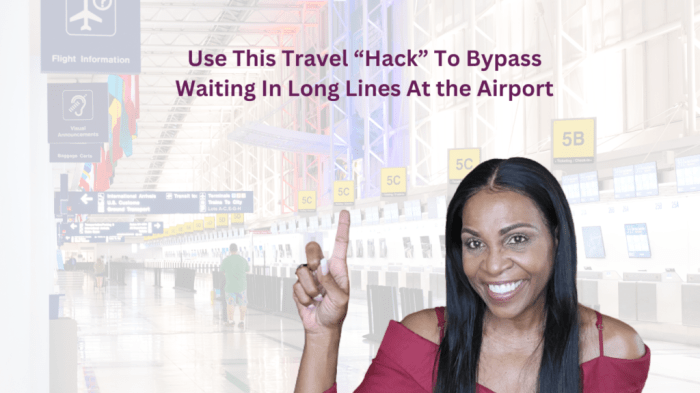
Navigating airport security can be a stressful experience, especially when faced with lengthy TSA lines. However, with a little planning and the right strategies, you can significantly reduce your wait time and start your trip off relaxed. This guide explores simple yet effective travel hacks designed to help you breeze through airport security checkpoints efficiently and minimize those frustrating delays.
We’ll cover a range of techniques, from leveraging TSA PreCheck and Global Entry programs to optimizing your travel timing and packing strategically. We’ll also delve into the use of technology, showcasing helpful apps and resources that provide real-time information on TSA wait times and offer alternative methods for streamlining the security process. By the end, you’ll be equipped with the knowledge to confidently tackle airport security and enjoy a smoother, more stress-free travel experience.
TSA PreCheck/Global Entry Programs
Navigating airport security can be a stressful experience, but utilizing expedited screening programs like TSA PreCheck and Global Entry can significantly reduce wait times and alleviate anxiety. These programs offer a streamlined security process for eligible travelers, allowing them to keep their shoes, belts, and light jackets on, and keep laptops and liquids in their carry-on bags.
Benefits of TSA PreCheck and Global Entry
Both TSA PreCheck and Global Entry offer expedited security screening, saving travelers valuable time and reducing stress. TSA PreCheck is specifically designed for domestic air travel within the United States, while Global Entry encompasses international travel, including expedited customs and immigration processing upon arrival in the U.S. The benefit of faster processing extends beyond just the security checkpoint; with Global Entry, you can bypass longer lines at customs and immigration, making your entire travel experience smoother.
This is particularly advantageous during peak travel seasons or at busy airports.
Application Process, Cost, and Eligibility Requirements
Applying for either program involves an online application, a background check, and an in-person interview at a designated enrollment center. The application process for both programs is similar, requiring applicants to provide personal information, travel history, and undergo a background check. The cost for TSA PreCheck is $85 for a five-year membership, while Global Entry costs $100 for a five-year membership.
Eligibility requirements include being a U.S. citizen, national, or lawful permanent resident. Applicants must also meet certain criteria regarding criminal history and background checks. Individuals with certain criminal records or immigration violations may not be eligible.
Comparison of TSA PreCheck and Global Entry
TSA PreCheck and Global Entry share similarities in their expedited screening benefits, but they cater to different travel needs. TSA PreCheck focuses solely on domestic air travel security, while Global Entry extends its benefits to international arrivals, providing expedited customs and immigration clearance. While both programs require a background check and application fee, Global Entry includes TSA PreCheck as a benefit, making it a more comprehensive option for frequent international travelers.
Choosing between the two depends on your travel patterns; if you primarily travel domestically, TSA PreCheck is sufficient. However, if you frequently travel internationally, Global Entry offers greater value and convenience.
TSA PreCheck vs. Global Entry: Feature Comparison
| Feature | TSA PreCheck | Global Entry | Cost |
|---|---|---|---|
| Application Fee | $85 | $100 | Five-year membership |
| Expedited Screening | Domestic air travel security | Domestic air travel security & International customs/immigration | Reduces wait times |
| Eligibility | U.S. citizen, national, or lawful permanent resident | U.S. citizen, national, or lawful permanent resident | Subject to background check |
| Benefits | Faster domestic security lines | Faster domestic security lines & faster international customs/immigration lines | Improved travel experience |
Timing Your Travel

Strategic scheduling is key to navigating airport security efficiently. By understanding peak and off-peak travel times, you can significantly reduce your wait time at TSA checkpoints. This involves considering both the time of day and the day of the week.Understanding how different times of day and days of the week impact wait times allows for proactive travel planning.
Generally, mornings tend to be busier than afternoons, and weekdays are usually more crowded than weekends. However, these patterns can vary based on specific airports and seasonal fluctuations.
Weekday versus Weekend Travel
Weekends typically see a higher volume of leisure travelers, leading to potentially longer wait times at TSA checkpoints. Conversely, weekdays often have a mix of business and leisure travelers, but the overall volume might be lower, particularly during midday. For example, a Tuesday afternoon at a smaller regional airport might have significantly shorter lines than a Saturday morning at a major international hub like LAX or JFK.
The distribution of travelers shifts, with a noticeable increase in leisure travel on weekends and a higher concentration of business travelers during the weekdays.
Optimal Travel Times
Early morning flights (before 6:00 AM) or late-night flights (after 9:00 PM) often have shorter lines than mid-day flights. This is because many travelers prefer to avoid early wake-up calls or late-night travel. Midday flights, particularly those departing between 10:00 AM and 2:00 PM, tend to be the busiest. Consider these times as the peak hours.
Utilizing Flight Tracking Apps
Many flight tracking apps provide real-time updates on airport wait times at TSA checkpoints. These apps often gather data from various sources, including airport sensors and passenger feedback. By checking these apps before heading to the airport, you can get a realistic expectation of wait times and adjust your departure time accordingly. For instance, if an app shows unusually long wait times at your departure airport, you can allow extra time or even consider adjusting your travel plans if possible.
This proactive approach can save you valuable time and reduce stress.
Visual Representation of Ideal Travel Times
Imagine a graph. The horizontal axis represents the time of day, from early morning to late night. The vertical axis represents the average TSA wait time. The graph would show a relatively low wait time in the early morning hours (before 6:00 AM), a gradual increase until it peaks between 10:00 AM and 2:00 PM, then a gradual decrease in the afternoon and evening, with another low point in the late night (after 9:00 PM).
A similar graph could be created for days of the week, showing generally lower wait times on weekdays (excluding peak hours) compared to weekends. The ideal travel times would be represented by the lowest points on these graphs, highlighting the early mornings and late evenings as optimal departure times.
Packing Smart
Efficient packing is crucial for a smooth and swift TSA experience. Minimizing the number of items you carry and strategically organizing your belongings can significantly reduce your time at the checkpoint. Careful consideration of what you pack and how you pack it can mean the difference between a quick passage and a frustrating delay.Packing efficiently involves thoughtful planning and a focus on minimizing items that could trigger additional screening.
This not only saves time at the checkpoint but also reduces the weight of your carry-on, making it easier to maneuver through the airport.
Items Commonly Causing Delays and Their Alternatives
Certain items frequently cause delays at TSA checkpoints due to their potential for security concerns. Liquids exceeding the 3-1-1 rule, bulky electronics, and items with sharp edges are prime examples. Replacing these with suitable alternatives can streamline the screening process. For instance, instead of carrying large bottles of shampoo, consider using travel-sized containers or purchasing toiletries at your destination.
Similarly, opt for a lightweight laptop instead of a bulky desktop computer, and choose clothing without excessive metal embellishments.
Organizing a Carry-On Bag for Quick Screening
To facilitate quick and easy screening, organize your carry-on bag strategically. Place all liquids in a clear, quart-sized bag for easy access. Keep electronics separate from other items and readily available for removal. Place items such as belts, jewelry, and shoes in a separate, easily accessible compartment to speed up the removal process. Consider using packing cubes to separate and compress clothing, which keeps your bag organized and reduces wrinkles.
This method allows TSA agents to quickly see the contents of your bag without having to unpack everything. For example, a well-organized bag might have a dedicated section for electronics, another for liquids, and a third for clothing, each neatly contained within packing cubes.
Essential and Non-Essential Items for Air Travel
Careful planning of what to pack is crucial for a smooth journey. Before you even begin packing, consider your itinerary and the climate at your destination. This will help you determine the essential items to include and avoid unnecessary baggage.
- Essential Items: Passport/ID, boarding pass (printed or digital), medications (with prescription if needed), wallet/money, phone and charger, travel-sized toiletries (in a quart-sized bag), comfortable clothing, a light jacket or sweater, any necessary electronics (laptop, tablet, etc.).
- Items to Avoid: Excessive amounts of liquids or gels, prohibited items (as per TSA guidelines), sharp objects (knives, scissors), bulky or heavy items (unless absolutely necessary), unnecessary electronics, and items that could easily break or spill.
Utilizing Technology
In today’s digital age, leveraging technology can significantly reduce your stress levels when navigating airport security. Several readily available tools and programs can help you bypass lengthy lines and expedite your journey through TSA checkpoints. Smart use of these resources can transform a potentially frustrating experience into a smooth and efficient one.
Mobile applications and websites offer real-time updates on TSA wait times, allowing you to strategically plan your arrival at the airport. Similarly, digital boarding passes and identification can streamline the check-in and security processes, minimizing the time spent waiting in line. Finally, programs like Mobile Passport Control offer a convenient alternative for expedited processing through customs and immigration.
Mobile Apps for TSA Wait Times
Several mobile applications provide real-time information on TSA wait times at various airports. These apps often utilize data from various sources, including airport sensors and user submissions, to give you a reasonably accurate estimate of the current wait times at different checkpoints. This information allows travelers to make informed decisions about when to arrive at the airport and which security lines to utilize.
| App Name | Key Features | Usability |
|---|---|---|
| MyTSA (TSA Official App) | Real-time wait times, security checkpoint maps, FAQs, and travel tips. | User-friendly interface; readily available information. |
| FlightAware | Provides flight status, delay information, and often includes TSA wait time estimates for many major airports. | Comprehensive flight information, but TSA wait times may not be available for all airports. |
| Airport Parking | While primarily focused on parking, many versions of this app integrate real-time security wait times as a value-added feature. | Convenient if you’re already using the app for parking; the TSA wait time feature may be secondary. |
Mobile Boarding Passes and Digital Identification
Using mobile boarding passes and digital identification, such as a digital driver’s license or TSA PreCheck mobile credential, significantly speeds up the check-in and security processes. Instead of fumbling with paper documents, you can quickly present your digital credentials to TSA agents via your smartphone, reducing the overall processing time at each checkpoint. Many airlines and states now offer digital versions of their boarding passes and identification documents, making this option increasingly accessible to travelers.
For example, many US states now have digital driver’s licenses that can be stored in mobile wallets and used for identification purposes at TSA checkpoints.
Mobile Passport Control
The TSA’s Mobile Passport Control (MPC) program allows eligible travelers to submit their passport and customs declaration information electronically via a mobile app before arriving at the airport. Upon arrival, travelers simply scan a QR code generated by the app at a designated kiosk. This process significantly reduces wait times at the customs and immigration checkpoints, especially during peak travel periods.
The program is available to citizens and nationals of the United States, Canada, and certain other countries. The MPC app simplifies the process and allows for quicker processing compared to the traditional paper-based method.
Travel Hacks Overview (Broader Scope)

Beyond efficiently navigating airport security, a truly smooth travel experience hinges on a broader range of strategies and preparations. This section explores various travel hacks to enhance your journey, from securing comprehensive insurance to capturing memorable travel photographs.
Travel Insurance: Coverage Options and Importance
Travel insurance is a crucial investment, offering financial protection against unforeseen circumstances. Policies vary widely, so understanding the different coverage options is essential. Basic plans often cover trip cancellations or interruptions due to illness or unforeseen events. More comprehensive policies may include medical emergencies abroad, lost luggage compensation, and even emergency evacuation services. Consider the specific risks associated with your destination and travel style when choosing a plan.
For example, a trip to a remote hiking location would necessitate a policy with robust medical evacuation coverage, while a city break might prioritize lost luggage protection. Reading policy details carefully before purchasing is vital to ensure the coverage aligns with your needs.
Travel Photography Techniques
Capturing stunning travel photographs can significantly enhance your travel memories. Mastering basic composition techniques is key. The rule of thirds, for instance, suggests placing key elements off-center to create a more visually appealing image. Leading lines, such as roads or fences, can guide the viewer’s eye through the photograph. Furthermore, understanding light is crucial.
The “golden hour,” the period shortly after sunrise and before sunset, offers soft, warm light ideal for photography. Experiment with different angles and perspectives to capture unique and memorable shots. Consider using a tripod for sharper images, especially in low-light conditions. A well-composed photograph of a bustling marketplace at sunset, utilizing the golden hour’s soft light and the rule of thirds to highlight a particular stall, would be an example of a successful application of these techniques.
Essential Travel Tips for Diverse Destinations
Preparing for a trip involves more than just booking flights and accommodation. Packing lists should be tailored to the destination’s climate and activities. For a tropical beach vacation, lightweight clothing, swimwear, and sunscreen are essential; a winter ski trip demands warm layers, waterproof outerwear, and appropriate footwear. Cultural sensitivity is paramount. Researching local customs and etiquette beforehand demonstrates respect and avoids potential misunderstandings.
For example, understanding appropriate dress codes for religious sites or knowing the local customs regarding greetings and tipping can significantly enhance your travel experience. In many cultures, direct eye contact might be considered rude, whereas in others, it’s a sign of respect. Adapting your behavior to reflect these differences is crucial for positive interactions.
Further Travel Related Topics
Planning international trips often involves navigating a complex web of regulations and considerations beyond simply booking flights and accommodation. This section delves into several crucial aspects of travel planning, from visa acquisition to understanding the benefits of different vacation styles and the impact of investment on the travel industry.
Obtaining Travel Visas
Securing the necessary travel visas is a critical step for international travel. The process varies significantly depending on your citizenship and your destination country. Generally, you will need to apply through the embassy or consulate of the country you plan to visit. Required documentation typically includes a valid passport, a completed visa application form, proof of sufficient funds, a travel itinerary, and possibly a letter of invitation from someone in the destination country.
Some countries may also require biometric data, such as fingerprints and photographs. The processing time can range from a few days to several weeks, so it’s essential to apply well in advance of your travel dates. For example, applying for a Schengen Visa for travel within the European Union often requires submitting extensive documentation and can take several weeks to process.
Conversely, obtaining a visa for some countries may be a more streamlined process. Always check the specific requirements on the official website of the relevant embassy or consulate well before your planned travel dates.
The Appeal and Benefits of Urban Escapes
Urban escapes offer a compelling alternative to traditional beach vacations or countryside retreats. These trips focus on exploring the cultural, historical, and culinary offerings of major cities. The benefits include experiencing diverse architecture, engaging with local art and music scenes, and sampling unique cuisines. For example, a trip to explore the historical sites and vibrant food markets of Rome offers a vastly different experience compared to a relaxing beach vacation.
Urban escapes can also be more budget-friendly depending on the city and the time of year, as many cities offer a variety of free activities and affordable food options. The fast-paced, exciting atmosphere of a city can be a refreshing change for travelers seeking a more stimulating vacation.
Comparison of Different Vacation Packages
Vacation packages, offered by travel agencies or online platforms, bundle various travel components like flights, accommodation, and sometimes activities or excursions at a discounted price. These packages can range from all-inclusive resorts catering to relaxation to adventure tours focusing on outdoor activities. All-inclusive packages typically offer a fixed price covering meals, drinks, and certain activities within the resort.
Adventure packages, on the other hand, may include guided hikes, wildlife safaris, or other thrilling experiences, often at a higher price point. The value of a vacation package depends on individual preferences and travel styles. A family might find an all-inclusive resort ideal for relaxation and convenience, while a group of adventurous friends might prefer an activity-focused package.
Careful comparison of prices and included services is crucial to determine the best value for your needs.
Vacation Programs for Employees
Many companies offer vacation programs as a form of employee benefit. These programs can provide employees with paid time off, subsidized travel, or access to discounted vacation packages. The benefits include increased employee morale and productivity, improved work-life balance, and reduced stress levels. For example, a company might offer a program where employees receive a certain number of paid vacation days per year or contribute a percentage of their salary to a travel fund.
These programs can also help attract and retain top talent, particularly in competitive industries. The specific features and benefits of these programs vary greatly depending on the company and its size.
Venture Capital in the Travel Industry
Venture capital plays a significant role in driving innovation within the travel industry. Investment funds provide crucial financial support for startups and established companies developing new technologies and services, such as innovative booking platforms, sustainable tourism initiatives, and personalized travel experiences. This investment fuels the development of mobile applications, artificial intelligence-powered travel planning tools, and other advancements that enhance the traveler’s experience.
For example, the rise of ride-sharing services like Uber and Airbnb demonstrates the significant impact of venture capital in disrupting traditional travel models. This influx of capital fosters competition and leads to improved services and lower prices for consumers.
Ultimately, avoiding long TSA lines is achievable with a combination of proactive planning and the utilization of available resources. By understanding the benefits of programs like TSA PreCheck and Global Entry, strategically choosing your travel times, packing efficiently, and employing helpful technology, you can significantly reduce your wait times at airport security. Remember that a little preparation goes a long way in ensuring a smoother and more enjoyable travel experience, allowing you to focus on the excitement of your journey rather than the stress of security lines.
Question & Answer Hub
What if I forget my TSA PreCheck/Global Entry number?
Most airlines allow you to add your Known Traveler Number (KTN) to your booking even after check-in. Contact your airline’s customer service for assistance.
Can I bring my new, unopened bottle of shampoo through security?
No, liquids must be in containers of 3.4 ounces (100ml) or less and fit inside a quart-sized, clear, resealable bag.
Are there any age restrictions for TSA PreCheck or Global Entry?
Children under 12 may be included in a parent’s application, but must be present for the interview. There’s no upper age limit.
What if my flight is delayed, and I miss my TSA PreCheck window?
Unfortunately, TSA PreCheck is tied to your specific flight and time. You would need to go through standard security.







